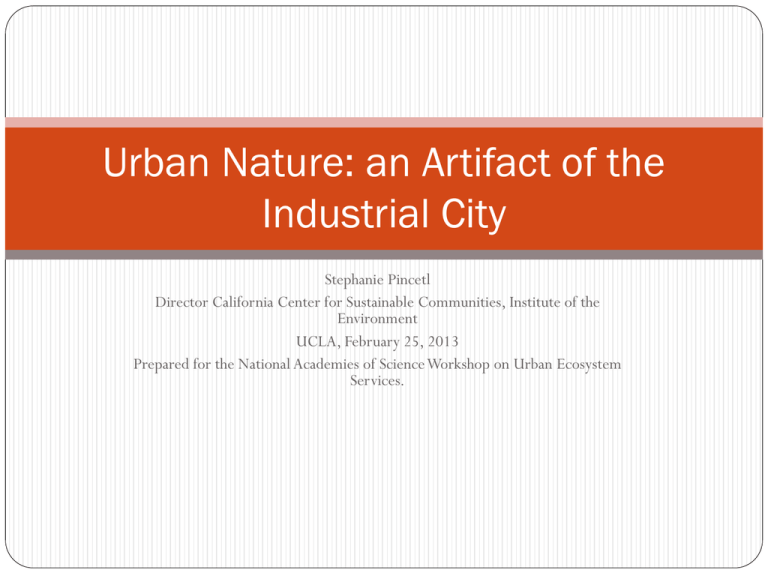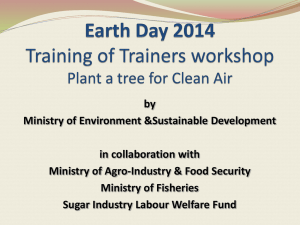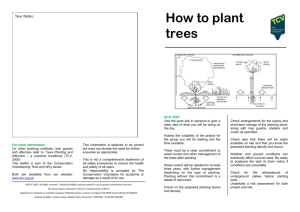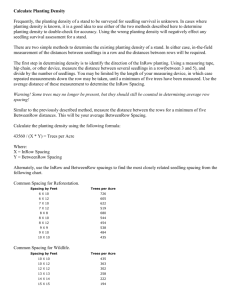here - California Center for Sustainable Communities
advertisement

Urban Nature: an Artifact of the Industrial City Stephanie Pincetl Director California Center for Sustainable Communities, Institute of the Environment UCLA, February 25, 2013 Prepared for the National Academies of Science Workshop on Urban Ecosystem Services. The New Age Humans are now urban Humans shape many Earth processes We are in the era of the Anthropocene Raises questions about what it is to be human in an urban age, how cities are built and grow and our “need for nature.” Cities are nature, inert minerals transformed by humans into infrastructure. Where does living nature fit in? A Bit of Perspective: Why Urban Ecosystems Today? Until the industrial revolution, cities were essentially devoid of living nature, except for elite gardens. Sienna, Italy There was a hierarchical order of civilization out toward the wilderness Civilization Agriculture, the Countryside Wilderness Nature was feared and powerful Wilderness Wolves Bears Predators of all kinds competing for food Fires, floods Agriculture was a struggle against weather, weeds, animals, soils, water supply, and trees. Harnessing of fossil energy enables industrialization and transforms the human relationship to the planet Fossil energy enables dramatic transformations of nature, enormous manufacturing productivity, the concentration of humans in urban centers as never before. Nature is dominated. Rise of Industrial City – polluted, crowded, insalubrious Lower East side Enter the Industrial City Globe Iron Works Ship Yard, Cleveland But living conditions in cities were abysmal Tree-lined streets and parks were seen as agents of change to make cities more livable. Olmsted’s Central Park as the lungs of the city for the working class : “A park is a work of art, designed to produce certain effects on the mind of men.” Rise of landscape architecture and interest in the exotic, including plants that were non-native. Reflection of a new cosmopolitanism, reaching far beyond the local. Status. Andrew Jackson Downing promulgates landscape architecture for the wealthy and budding middle class professional class. Conjuncture of science, industrial despoliation of the countryside and urbanization George Perkins Marsh – importance of trees for watershed functions leads to preservation of forests still in the public domain. Rise of Preservation movement – idealization of nature: Painting (Hudson River School, luminists), Romantic and Transcendentalist Mvts. Nature as solace, repose and inspirational. A source of regeneration. Bierstadt, Among the Sierra Nevada Mountains, 1868. Tree Planting Movement in Cities Urban expansion west of the 100th meridian into the treeless plains provokes deliberate urban tree planting, starting in 1870s in Nebraska with the founding of Arbor day. Citizen-based urban tree planting spreads (mostly in affluent areas). Tree planting becomes a civic obsession. Association of virtue with trees. In US emphasis was on neighborhood trees (planted by individuals along streets). Civic Boosterism and Trees Liberty Hyde Bailey and the Country Life Commission enlisted by Pinchot to extol the virtues of trees in towns. Country churches source of tree stewards in cities. Pinchot advocated tree planting in towns for moral and environmental reasons. There is early collaboration between the Forest Service and urban tree planting efforts. Normalization of Eastern Seaboard, English aesthetic of a mesic, green environment, a green leafy environment. Lands west of the 100th meridian caused great controversy about how to manage (John Wesley Powell). Irrigate them, make them like the mesic East. Twentieth Century Sees Parks and Open Space Become Normalized Parks and open spaces become normalized as part of urban planning and design. They are seen as part of health of residents. With postwar prosperity leaps and bounds in urban expansion. Mid Twentieth Century (re)Rise of Concern about Nature and the Environment Concerns about the preservation of nature. Rachel Carson sounds the alarm on chemicals. National Recreation Areas under Kennedy (Outdoor Recreation Review Commission (1964)). Environmental movement. 1970s formal federal Forest Service assistance for urban tree planting. City Tree USA: U.S. Forest Service and National Association of State Foresters, partly funded by USFS, cosponsored by US Conference of Mayors and National League of Cities. All quite apart from recent rise of interest in urban ecosystem services. Urban Sustainability of the 1980s Forward Cities can be sites of their own pollution and impacts remediation (Rees & Beatley). An urban nature can be developed to help in this endeavor, as it can provide provisioning, regulating, cultural and possibly supporting services. Trees become emblematic of urban ecosystem services in cities across the country and million tree planting programs become the rage – see Vibrant Cities etc. . . But what is sustainable for whom where? Do alleged services add up? Some parts of the country are naturally treeless and water restricted, planting trees requires water resources. Trees require maintenance – they are living entities, this requires funding. Tree maintenance requires either specialized knowledge or money; what if the city and residents have neither? Not all people like trees. Other ecosystem services like bioswales, water infiltration trenches are also costly, even more so. Also require fundamental changes in urban morphology. Urban Ecosystem Services Implementation Will require new forms of public administration and different rules to create new agencies, sharing of budgets, co-management of new infrastructure (water and sanitation, for example with street services). Needs new sources of funding. Requires new skills to maintain “living infrastructure.” Each region will have different climatic tolerances and ecosystem services will have to be appropriate to the conditions. Success will depend on public acceptance of a different looking city, and willingness to lend their individual private property to the effort. Requires public support and involvement – a deep shift involving public stewardship, new ideas of property rights and obligations. The sanitary city of the 20th Century needs to be retrofitted so natural processes can work to help mitigate urban impacts, and to make for the sustainable city of the 21st Century. What are the urban benefits? Quantification of urban ecosystem benefits difficult. Trees perform differently across different ecosystems and in different urban locations. And, does their performance translate to the benefits claimed like reducing the use of air conditioning or GHG emissions sequestration. How do you know? Trees are brutally pruned, their ecosystem service is severely curtailed. How is this taken into account? They have costs as well as benefits. A typical street tree in LA Pruning cycle: 60 years. Value of the ecosystem service??? Portland: how much did this cost? How many linear miles are necessary to make a difference? Lots of concrete here, what is the trade-off between the GHG emissions of concrete vs. stormwater infiltrated for example? Value of these urban ecosystem services? Still unknown, largely a matter of faith. Represents the instrumentalization of nature. We have gone from fear and vulnerability of nature’s impacts and processes, to domination and pricing of its functions with meager quantification compared to the complexity of what is being proposed, and no effort to address the public administration and land management changes necessary to implement the changes proposed. Issues of beauty and wellbeing are unaddressed. Yet this humans are now urban dwellers and our relationship with nature has changed. Do we need it to be happy? To feel good?











